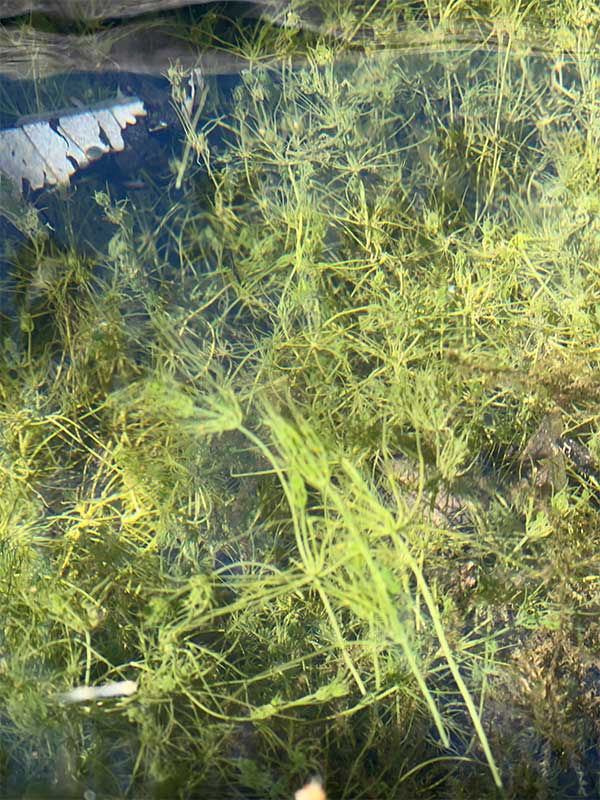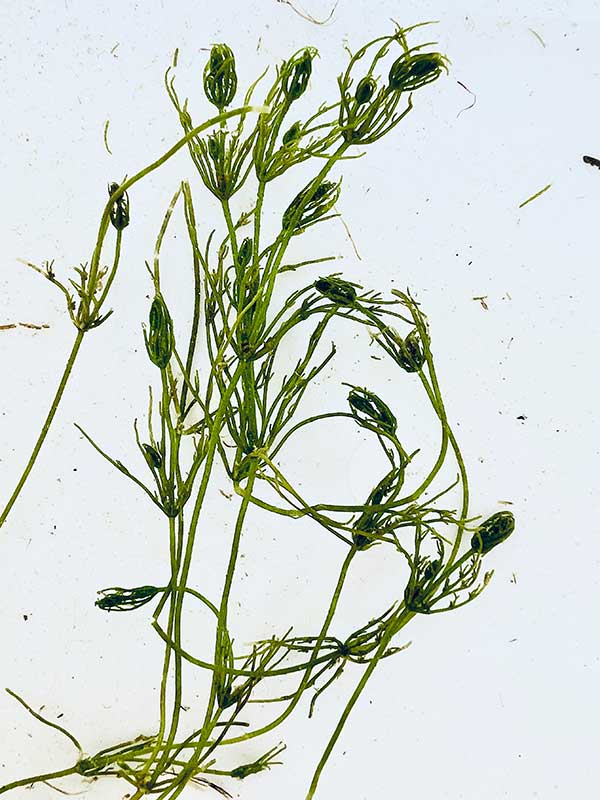Chara contraria / Chara
- plant-like rooted aquatic alga
- green “stem” with whorls of green “leaves”
- rough feeling due to carbonate encrustations
- river bottom but other waters, including stock tanks
Also known as: muskgrass, aquatic horsetail, opposite stonewort
Synonym: Chara vulgaris var contraria
Chara is a genus of green algae that grows submerged in clear, clean, alkaline, still or gently flowing waters. Thus, the Teton River is a pretty good place for it. On the other hand, the main image in the gallery here was taken at a stock tank on a trail in Dry Henderson Canyon, and it didn’t really seem all that clean.
Chara has well-developed, root-like rhizoids which anchor it in the muddy substrate. Unlike true roots, rhizoids are clear and lack root caps. Well, and all the other structures found in roots of vascular plants.
The shoot-like central axis has regularly-spaced nodes or joints, from each of which grow whorls of leaf-like branches. Because of these characters, Chara is often mistaken for a vascular aquatic plant. However, like other algae, Chara lacks real leaves, flowers, seeds and vascular tissues. In C. contraria, the single cell forming the internode is surrounded by a layer of much smaller cortical cells. Thus, this species is “corticate”. (There are also species lacking the cortex.)
In many Chara species, including C. contraria, the shoots are encrusted with lime (calcium carbonate). This gives them a rough feel and the common name, stoneworts. On the other hand, the plants also have a garlic-y or skunky odor when crushed, giving rise to the alternate common name, “muskgrass”.
Chara reproduces vegetatively and sexually. Vegetative reproduction takes place by tubers or by fragmentation and “rooting”. Sexual reproduction depends on swimming sperm rather than pollen, produced in structures called globules. The female gametophyte is a nucule. Neither looks at all like a flower (see gallery photo).
Interesting bits – There is another genus of algae, Nitella, which is similar to Chara. However, it’s smooth to the touch and doesn’t smell bad when crushed. One way to tell them apart, at least mostly and certainly in the Valley, is by the fact that Nitella prefers acidic water while Chara is found in alkaline, “hard” water. Basically, Nitella isn’t here. There is also one other interesting confusion: the overall appearance of Chara is similar to that of the land-plant, Equisetum. Hence, Chara is sometimes called the aquatic horsetail.
Although the plant is not especially plentiful in the open river, it can be in some of the backwaters. In the gallery, there is a photo of a thick Chara growth in very shallow water over thick muck.
Chara is an important part of aquatic ecosystems, at least partly because it provides food and cover for wildlife, including fish, fowl and grazing insects. The latter, of course, eventually provide food for fish and other wildlife, too. Interestingly, however, mosquito larvae are not found in waters with Chara. In addition, the rhizoids stabilize the sediment, helping to keep the water clear. Finally, if the population of Chara is dense enough, it can be harvested as green manure.
| Family | |
|---|---|
| Where? |



